The Marketing Hierarchy
(Psychology VS Tactics)
The reason most marketing fails to attract and convert clients is because it's too focused on tactics, tools, and tricks.
...and ignores the real causes behind why clients actually buy, and why they don’t.
SPOILER: It has to do with psychology and how the marketing brain works (...but more on that later)
If you're like most of my clients and students then at some point you may have wondered...
Why do some businesses thrive, despite having an inferior service or appearing to care less about their clients?
Why do some clients seem interested to buy, but then back away at the last moment or go cold?
And why sometimes, do even your best and most compelling offers and pieces of content go unheard and ignored by your market?
Well, the answer is the brain.
More specifically, your client's brains. And the fact that their brains are doing exactly what they were designed to do - which is to quickly evaluate information and situations in order to gain pleasure, avoid pain, and keep them alive (and that hasn't changed in tens of thousands of years).
Marketing fails when it ignores this. And attempts to "outsmart" the brain and its amazing capacity to evaluate, process, and interpret information. Automatically. And instantaneously.
This is why marketing based on tricks, tools, and tactics, and that ignore strategic marketing fundamentals and psychological principles are all but destined to fail.
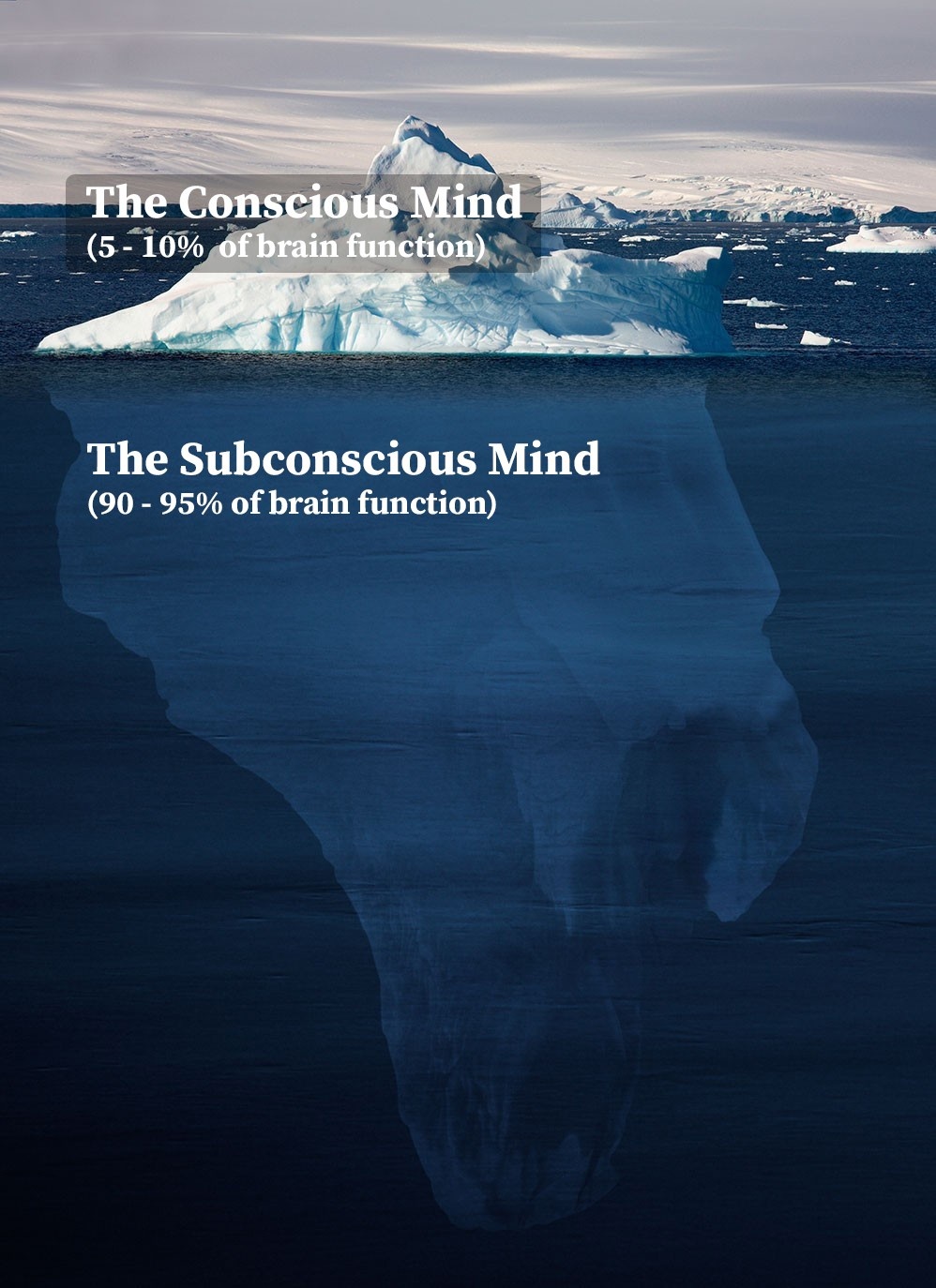
The mind acts a lot like an iceberg with most of the decisions being made automatically, subconsciously, and without anyone even noticing.
Psychological Triggers & Cognitive Biases
The world is a loud and confusing place which means our brains need to use a number of different mental shortcuts (known as heuristics), to help to ease the cognitive load of making decisions and evaluating information.
What’s interesting though is that these mental shortcuts all take place subconsciously, and instantaneously... and without anyone ever noticing.
And this is a good thing, Because if we had to consciously process everything we think (over 6000 thoughts a day)
...everything we do (from eating to breathing to brushing your teeth)
...and everything we see (the average person now sees upwards of 10,000 ads alone every day).
Well, our minds would overheat, shutdown, or explode.
So the fact that most of the mental work we do on a day to day basis takes place automatically, subconsciously, and without any actual "thinking" required keeps us sane, and alive.
But it also leads to a few cognitive biases, which are "systematic errors in thinking that occur when people are processing and interpreting information in the world around them and affects the decisions and judgments that they make."-VeryWellMind
Basically, these mental shortcuts save time and energy. But they also make mistakes and occasionally misrepresent just how important something is.
- For example, this is why you’ve been told that making a good first impression matters so much. It’s because this first impression is going to impact every single thought, feeling, and opinion someone has of you moving forward, and they’re very hard to change. This is a cognitive bias known as the “Halo Effect”.
- Or why the first and last thing someone hears are perceived as being the most important, and will be given mental priority above anything else that’s said. This is known as the “Serial Position effect”.
- Or why we always look to see what others around us are doing to help us make a decision or decide what the best choice is. This is known as the “Bandwagon Effect” and it’s the reason that social proof and testimonials are so powerful in marketing.
- Or why the more often we see something, the more likely we are to like and trust it. This is known as the “Mere Exposure Effect”.
- Or why the first price someone hears “anchors”, or sets the frame from which they will judge all future numbers against, known as “Anchoring”. Even if this number is unrealistically high, or low, it still anchors itself and has an impact. In fact, even when someone is told to not let this anchoring affect their perception, it still does.
- And there are more. Many more. Many, many more!
This is why focus groups often fail ("The Bandwagon Effect" takes place when everyone agrees automatically with everyone else).
Why asking people directly what they think doesn’t work ("Attribution Error" shows that what people feel is context and environment specific).
And why most of the traditional marketing strategies that are based on anything other than psychological principles are destined to fail (due in part to over 185 different cognitive biases).
This cognitive bias codex is available here: https://upload.wikimedia.org/wikipedia/commons/6/65/Cognitive_bias_codex_en.svg
Strategy. Structure. Sequence.
Fortunately, you don't need to memorize (or even know) all 185 different cognitive biases in order to create marketing that works.
Not all of these biases and triggers are relevant. And not all of them are equally powerful.
The important thing to know is that there are psychological factors at play that are so powerful that even when you know they’re being used against you, you still can’t stop them.
And neither can your clients.
But the key to really maximizing the effectiveness of your marketing and message you need to deploy these factors in a strategic sequence that works with how your client's brains naturally process and evaluate information.
Laying them out one by one. Each one building on the last. Guiding. Leading. And caring. Each and every single step of the way.
It's hard work. But when you get this right and you present your marketing information using a strategic and structured sequence, client resistance is lowered, their curiosity is engaged, and a path to purchase is established.
...a path to purchase that may just end up being 87% more effective at increasing content consumption and 56% more effective at increasing signups and conversions.
Not too shabby.
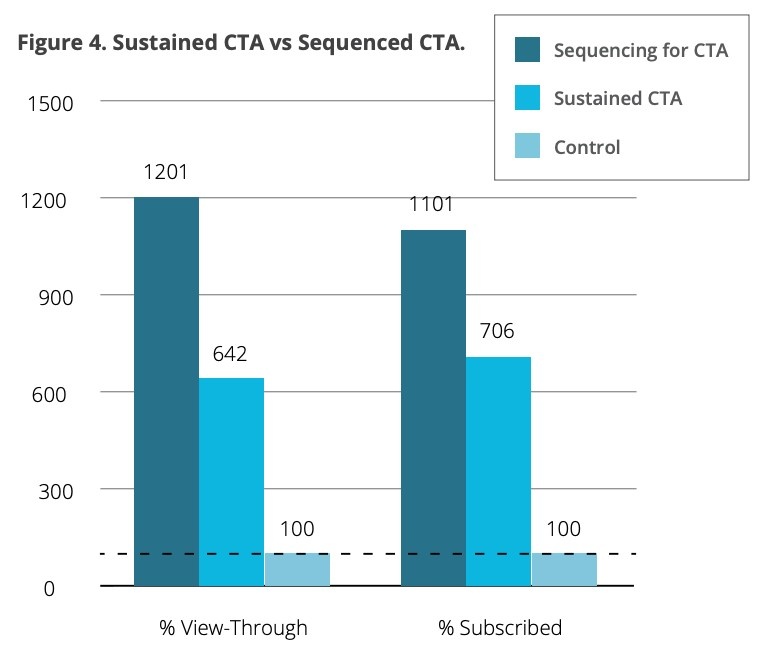
A U.S.-based advertising research study was conducted jointly by Adaptly, Facebook and Refinery29 in order to determine the differences in impact between presenting two types of marketing messages across an advertising campaign.
Its goal was to answer whether delivering marketing messages by leading a consumer down the marketing funnel (i.e. Sequencing) is more effective than simply delivering a single strategy call-to action (i.e. Sustained).
SPOILER: Sequencing won. By a lot.
Strategy, Structure & Sequence For The Win
But the best part of designing your marketing this way is that you’re able to trade in those old-school aggressive, hard-selling, and pushy marketing tactics that feel gross.
...for a more effective (and ethical) way that allows you to:
- Get more and better clients.
- Get more time (and financial) freedom.
- Have easier sales calls (or no sales calls at all) with pre-qualified and pre-sold clients that show up ready to sign up now.
- Make a bigger impact and to serve even more people.
- Get that feeling of success, confidence, and accomplishment in knowing that the business is moving in the right direction.
Best of all…
You now have a way to attract more perfect fit clients to grow your business on your terms.
Predictably, profitably, and without sacrificing your integrity in the process.
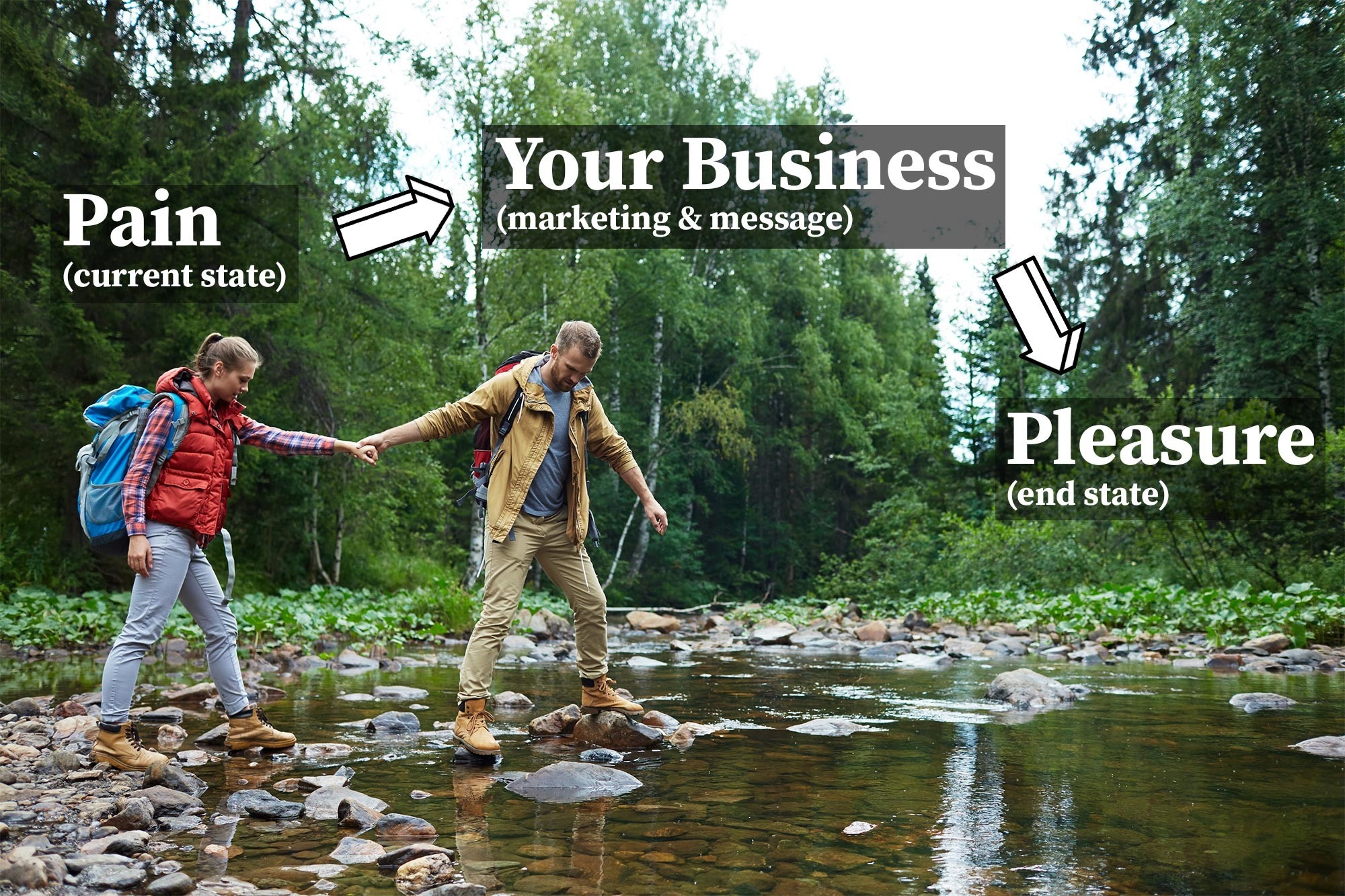
When you create marketing that meets clients where they are, takes them by the hand, and guides them from where they are now (pain) to where they want to go (pleasure) your clients feel heard, respected, and understood. And they buy.
The Online Business Rollercoaster
If you're like most of my clients and students then maybe some of this sounds familiar:
- You're great at what you do, you just wish more people knew about you and would give you a chance because then your business would grow.
- You may have heard the best way to get more clients was to network, cold-call, send never-ending DM's, or beat up your network for referrals. But that feels gross, slimy, and way too "salesy".
- You're a hard worker, but you often feel overwhelmed trying to figure out what to work on next. Especially when it comes to marketing.
- You've read the books, taken the courses, and signed up for the group programs. But are often disappointed with the generic advice and “one size fits all” solutions that never seemed to fit you.
- You don’t have a consistent, repeatable, or scalable process to generate leads, clients, and sales on demand, so you're stuck in the feast and famine cycle. Too busy one month, and scrambling for clients the next.
…and this leads to frustration. And is not a fun place to be.
I know these feelings because this was my exact story when I first started building my online business over 10 years ago.
The life of an entrepreneur isn't always easy. But it is worth it.
"Bro-Marketers" and Sketchy Tactics
It's frustrating being an unheard and ignored entrepreneur. Watching less ethical competitors skate by. And trying to figure out what's missing from your business that would allow you to grow.
But most of all it can be frustrating to look at the marketing industry as a whole (...“is it really this full of hucksters and snake oil salesman?”)
Skeptical of being told to use pushy tactics that don't fit your values.
And tired of sleazy, unethical, and just overall “gross” tricks that never feel good to use.
Plus, if you're like most people, you're also probably pretty sick and tired of seeing all these "Bro-Marketers" and fake “internet marketing millionaires”. Posing in front of rented Lamborghinis and Airbnb mansions. And shouting out one unbelievable hyped-up claim after another.
Gimme a break right?! What is this stuff?!
You may even be wondering, like I was so many years ago, if you're even cut out for this whole online business thing?

"Bro-Marketers" prey on greed, shame, and envy. While it can work to attract clients, it rarely (if ever) attracts the right kind of client (i.e. the ones that you actually want to work with).
Conventional Wisdom Yields Conventional Results
Of course along the journey to success there are the "usual fixes" and pieces of conventional wisdom.
Things like:
- Getting advice from friends (...and while their hearts are usually in the right place, few of them truly understand how the online business world really works)
- Books (which can be amazingly helpful, but often lack specifics and actionable strategies to implement)
- Online courses (there are some great ones out there! Helpful, and informative. But many are missing customization, personalization, and support. So you're left not really sure how to adapt the content to your unique business and situation)
- Masterminds (most of which are insanely expensive - and rarely worth the investment)
- And group programs (which are often good, but again, missing the expertise, guidance, and support needed)
- (SIDE NOTE: many group programs rely on untrained and unproven "coaches" that provide little more than accountability and the occasional "pep talk" reminding you to "work on your mindset")
Long story short, there's a lot of stuff out there but the reason that much of it doesn't work as well as it's supposed to (or doesn't work at all) has to do with the fact that it's built on tactics, tools, and tricks - not strategy and psychology (...but more on that shortly)
So if you've made progress in your business, but aren't yet at the level you want to be at.
Are feeling stuck. Stalled. Or unable to see the next step to take.
Or maybe even considering accepting your fate as doomed to struggle forever...
...never cracking the online business code.
...and never truly fulfilling your potential.
And forced to either embrace the "bro-marketing" tactics that go against everything you believe... or give it all up and go back to the corporate world and the "9 to 5" grind.
Just wait. There is another way.
What if the answer you're looking for isn't more (i.e. more tactics, more tricks, and more tools)
...but better? (i.e. strategic and psychologically driven marketing)

Henry Ford had a point when he said “If you always do what you've always done, you'll always get what you've always got.”
So if you want something better, then you need to find another, better way to do things.
A New Way To Market
Surely there has to be a better way to enroll perfect fit clients into your programs, courses, and services...
A way that isn't currently being preached but that focuses on empathy, connection, and building relationships.
A way to do marketing that is both ethical, and yet extremely profitable.
And a way that works just as well, or even BETTER than the "hit it and quit it" marketing philosophy that plagues our industry.
Most of all, a way that aligns with your values, ethics, and commitment to integrity.
Right?!
Well, if you're like most of my clients and students then this is what you may be looking for too.
A better, more effective, more ethical, and more profitable way to grow your business and attract more perfect fit clients without sacrificing your integrity or dying from stress in the process.
Fortunately, all of this is possible.
What actually makes a difference in your marketing is the psychology behind why clients buy… and why they don’t.
And the strategy to put the pieces together so you're doing the right things, in the right place, for the right people.
Tactics VS Psychology
Over the past 10 years I’ve worked with over 800+ clients who time after time kept coming to me with the exact same problems.
There are so many things that we as entrepreneurs are told to do that should work – but don’t. Or worse, work for a short time giving you a false sense of hope - before failing catastrophically and leaving you alone and wondering what just happened?!
The problem here is that most marketing trainings, courses, and "experts" today are all focused on tactics.
Creating marketing based on tricks, hacks, and "beating algorithms"
...rather than on what actually matters and makes a difference which is the psychology behind why clients buy… and why they don’t. And the strategy to put the pieces together so you're doing the right things, in the right place, for the right people.
The reality is that tricks, tools, and tactics are the lowest (and yet most common) form of marketing. They're often new, shiny, and fun so they're easy to sell. But they make up the lowest part of the marketing hierarchy and at best try to deliver short-term wins and a few vanity metrics such as getting more "likes", comments, or shares.
It's only when you move up to the strategy and ultimately psychology levels of the pyramid does your marketing (and business) really start to take off.
It's here in the upper echelons of strategy and psychology that you're able to create marketing that makes you irresistible to your clients and untouchable to your competitors.
The Marketing Hierarchy
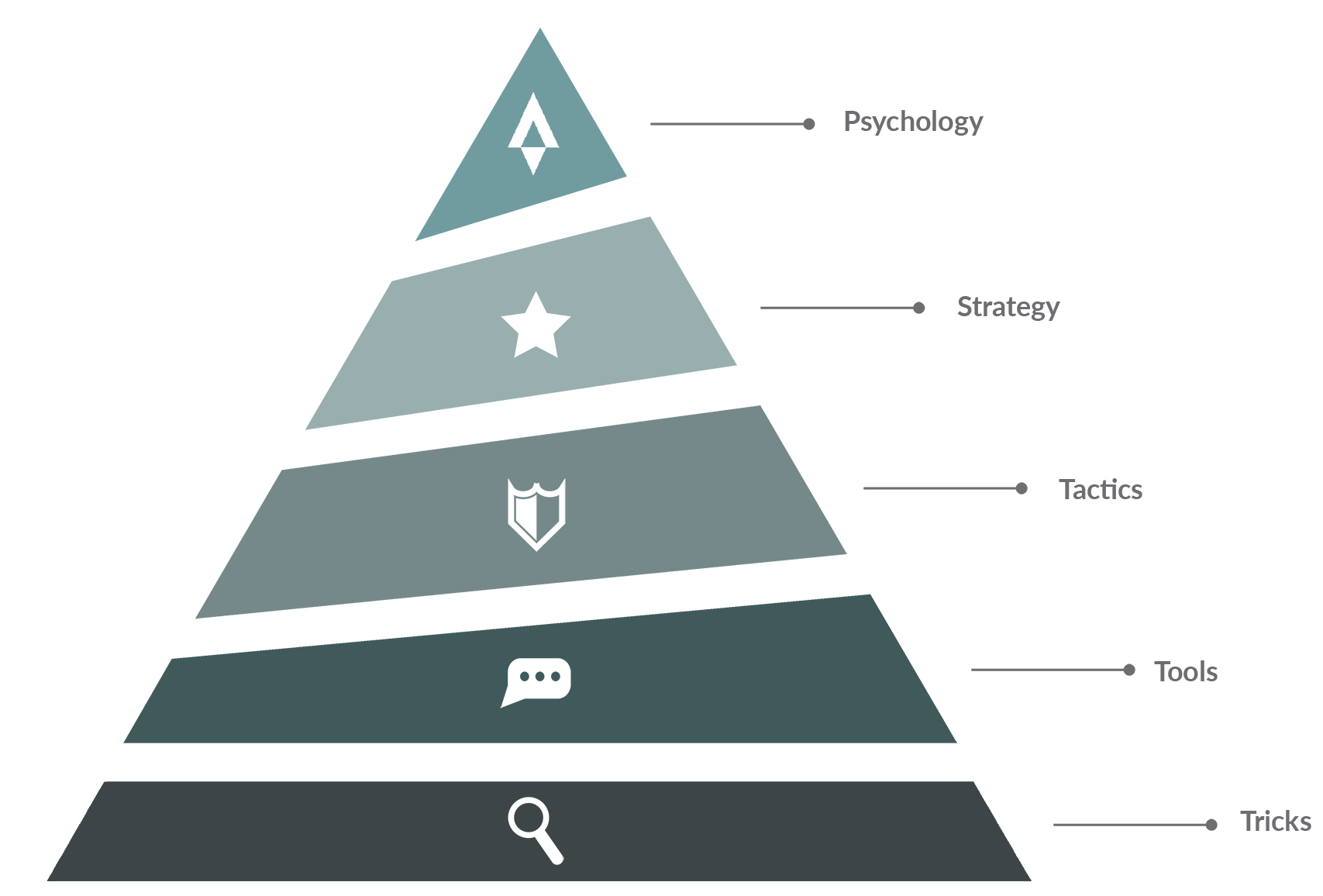
The lowest and least effective form of marketing is that based on tricks and hacks that try to game the system or the algorithms. From there it progresses up the hierarchy to tools, tactics, strategy, and ultimately, psychology - which is marketing based on proven principles of human behavior.
The 3-Keys To Success
(To Attract More & Better Clients)
Over the last 10 years I’ve found that there are actually only ever 3 things that really matter when it comes to creating marketing that attracts more perfect fit clients for your services, programs, or courses.
When you get these 3 things installed in your business, rather than shouting, pushing, and shaming people to buy (...like most traditional marketing approaches suggest you do)
...you get to meet clients where they are. Take them by the hand. And guide them from where they are now to where they want to go.
It’s more effective. It’s more ethical. And it’s far more profitable too.

